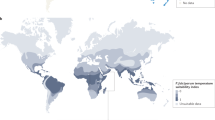Abstract
Multiple myeloma results from an interplay between the monoclonal malignant plasma cells and supporting nonmalignant cells in the bone marrow. Recent studies suggest that the final transforming event in this B cell disorder occurs at a late stage of B cell differentiation based on the characteristics of the immunoglobulin genes expressed by the malignant clone as well as surface markers present on the tumor cells. Recently, an increasing pathogenic role in this malignancy by the nonmalignant cells in the bone marrow has been suggested by several studies. Specific infection of these supporting cells by the recently identified Kaposi’s sarcoma-associated herpes virus (KSHV) suggests a novel mechanism by which this nonmalignant population may lead to the development of this B cell malignancy and support its growth.
This is a preview of subscription content, access via your institution
Access options
Subscribe to this journal
Receive 12 print issues and online access
$259.00 per year
only $21.58 per issue
Buy this article
- Purchase on Springer Link
- Instant access to full article PDF
Prices may be subject to local taxes which are calculated during checkout
Similar content being viewed by others
Author information
Authors and Affiliations
Rights and permissions
About this article
Cite this article
Berenson, J., Vescio, R. & Said, J. Multiple myeloma: the cells of origin – A two-way street. Leukemia 12, 121–127 (1998). https://doi.org/10.1038/sj.leu.2400947
Received:
Accepted:
Published:
Issue Date:
DOI: https://doi.org/10.1038/sj.leu.2400947
Keywords
This article is cited by
-
Identifying a confused cell identity for esophageal squamous cell carcinoma
Signal Transduction and Targeted Therapy (2022)
-
A Reappraisal of Immunoglobulin Variable Gene Primers and Its Impact on Assessing Clonal Relationships Between PB B Cells and BM Plasma Cells in AL Amyloidosis
Journal of Clinical Immunology (2011)
-
Novel Analysis of Clonal Diversification in Blood B Cell and Bone Marrow Plasma Cell Clones in Immunoglobulin Light Chain Amyloidosis
Journal of Clinical Immunology (2007)



